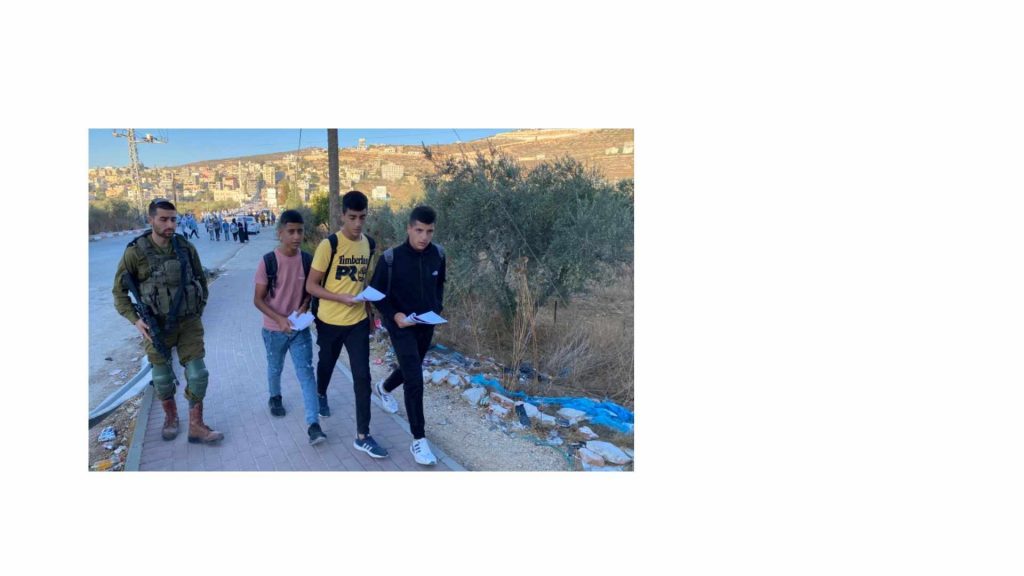
For the Palestinian children of Luban Ash-Sharqiya near Nablus, walking to school is a dangerous journey.
Luban Ash-Sharqiya, Occupied West Bank – Travelling to and from school is a normal, relatively straightforward activity for most children across the world.
But for kids from the Israeli-occupied West Bank village of Luban Ash-Sharqiya, south of Nablus, it is a game of cat and mouse, as they try to avoid Israeli settlers and soldiers on the roads leading from their school to their village.
Luban Ash-Sharqiya is home to about 3,500 Palestinians, 20km south of the city of Nablus in the northern West Bank. Two illegal Israeli settlements, Eli and Ma’ale Levona, straddle the sides of the village and are built on land belonging to it.
Every afternoon, Israeli military units are stationed at the village’s entrance near the main highway between Ramallah and Nablus.
Nearby Israeli soldiers patrol on foot as groups of schoolchildren from Lubban attempt to take alternative routes to get home following numerous settler attacks.
“I drive my son to and from school every day because I’m scared of him being hurt or arrested by the soldiers,” Maoud Awais told Al Jazeera.
His son Mahmoud, 11, said he was scared of the Israeli troops as he had seen his friends previously confronted by soldiers.
“We were in a group and the soldiers stopped us and threatened us,” Mahmoud told Al Jazeera.
Earlier this week, a military vehicle with two soldiers inside sped along the village road, swerving and skidding as it suddenly turned around next to a group of schoolgirls trying to make their way home and shouted at them.
In the agricultural area ahead, groups of schoolboys took an alternative route through village fields to get home as Israeli soldiers patrolled the main road.
“The soldiers often try and provoke the schoolchildren by whistling at them, calling out to them and stopping to search them as they accuse them of coming to the main road to throw stones at settler cars,” Falastin Noubani, a village resident, told Al Jazeera.
Attacking the school
Getting home from school is also a problem for children in the village of Urif, north of Luban Ash-Sharqiya, also in the Nablus governorate.
Amer Safadi, a municipal employee in Urif, said he also escorts his children to and from school to avoid them being injured by settlers from the Yitzhar settlement located on the next hill near the village.
“The settlers have attacked the school several times in the past,” Safadi told Al Jazeera.
He said the school was “forced to build an extended roof over the area outside the school building to stop the children being injured by stones thrown by the setters” after several windows were broken.
In May, a Palestinian man named Nidal Safadi was killed when settlers and Israeli soldiers raided the village and jointly shot him four times. A confrontation had broken out between villagers and the army, after the raid.
Last month, Al Jazeera witnessed Palestinian school children screaming in fear and running back towards their school in the Bethlehem village of Kisan as a settler car approached, on a road used jointly by the settlers and Palestinians, after school had finished for the day.
In the southern occupied West Bank, children from At-Tuwani and other nearby hamlets have had to have international observers and the Israeli military to accompany them as they walked long distances to school to avoid being attacked by settlers from the settlement of Ma’on.
But the traumatic experience of Palestinian children trying to avoid being attacked as they walk to and from school is not limited to a few villages. It is a systematic problem throughout the occupied West Bank.
According to an August 15 statement by Lynn Hastings, the UN humanitarian and resident coordinator for the occupied Palestinian territories, 24 Palestinian children – five girls and 19 boys – were injured by settlers in the West Bank since the beginning of the year.
“Israel has a responsibility to protect children and teachers from harassment and violence by settlers on their way to and from school – and in any event,” said Hastings.
“All parties must commit to the protection of children in accordance with international law no matter where they are.”
‘Infrastructure of terror’
Meanwhile, back in Luban Ash-Sharqiya the children reached home safely.
During the last few decades under Israeli occupation, the villagers have suffered numerous settler attacks beyond those on schoolchildren.
“Last week one of the villagers was assaulted and arrested by Israeli soldiers when villagers went to confront a group of settlers who were trying to take over another 20 dunams of village land,” Abdullah Malah from the Luban Ash-Sharqiya Municipality, told Al Jazeera.
Villagers said that over the years the settlers have destroyed land, killed animals, and taken over a nearby spring.
“The settlers often come into or near the village on Fridays when they know that most villagers are at home,” said Noubani.
In 2010 Al Jazeera visited the village after settlers had invaded and set fire to the local mosque. The gutted remains of the religious building required significant reconstruction after the arson attack.
In 2009, two members of Israeli rights group Yesh Din wrote in the daily Haaretz about settlers from Eli who had taken control over the area, which seriously damaged the ability of the villagers to work their land.
According to the rights campaigners, this is part of a systematic strategy to remove all Palestinians from Area C, which comprises 60 percent of the occupied West Bank and falls under Israeli control — but was meant to be returned to the Palestinians years ago.
The authors concluded that “an infrastructure of Jewish terror is being created in the West Bank”.
“The settlers are a big problem for the village,” Malah told Al Jazeera.
